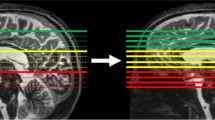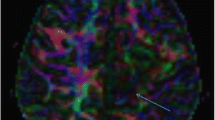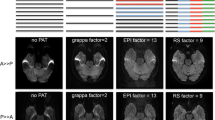Abstract
Pediatric neuroimaging is a complex and specialized field that uses magnetic resonance (MR) imaging as the workhorse for diagnosis. MR protocols should be tailored to the specific indication and reviewed by the supervising radiologist in real time. Targeted advanced imaging sequences can be added to provide information regarding tissue microstructure, perfusion, metabolism and function. In part 2 of this review, we highlight the utility of advanced imaging techniques for superior evaluation of pediatric neurologic disease. We focus on the following techniques, with clinical examples: phase-contrast imaging, perfusion-weighted imaging, vessel wall imaging, diffusion tensor imaging, task-based functional MRI and MR spectroscopy.




















Similar content being viewed by others
References
Markl M, Schnell S, Wu C et al (2016) Advanced flow MRI: emerging techniques and applications. Clin Radiol 71:779–795
Battal B, Kocaoglu M, Bulakbasi N et al (2011) Cerebrospinal fluid flow imaging by using phase-contrast MR technique. Br J Radiol 84:758–765
Hofmann E, Warmuth-Metz M, Bendszus M et al (2000) Phase-contrast MR imaging of the cervical CSF and spinal cord: volumetric motion analysis in patients with Chiari I malformation. AJNR Am J Neuroradiol 21:151–158
Hofkes SK, Iskandar BJ, Turski PA et al (2007) Differentiation between symptomatic Chiari I malformation and asymptomatic tonsilar ectopia by using cerebrospinal fluid flow imaging: initial estimate of imaging accuracy. Radiology 245:532–540
Stivaros SM, Sinclair D, Bromiley PA et al (2009) Endoscopic third ventriculostomy: predicting outcome with phase-contrast MR imaging. Radiology 252:825–832
Fukuhara T, Vorster SJ, Ruggieri P et al (1999) Third ventriculostomy patency: comparison of findings at cine phase-contrast MR imaging and at direct exploration. AJNR Am J Neuroradiol 20:1560–1566
Bargalló N, Olondo L, Garcia AI et al (2005) Functional analysis of third ventriculostomy patency by quantification of CSF stroke volume by using cine phase-contrast MR imaging. AJNR Am J Neuroradiol 26:2514–2521
Bradley WG Jr (2015) CSF flow in the brain in the context of normal pressure hydrocephalus. AJNR Am J Neuroradiol 36:831–838
Yamada S, Tsuchiya K, Bradley WG et al (2015) Current and emerging MR imaging techniques for the diagnosis and management of CSF flow disorders: a review of phase-contrast and time-spatial labeling inversion pulse. AJNR Am J Neuroradiol 36:623–630
Luetmer PH, Huston J, Friedman JA et al (2002) Measurement of cerebrospinal fluid flow at the cerebral aqueduct by use of phase-contrast magnetic resonance imaging: technique validation and utility in diagnosing idiopathic normal pressure hydrocephalus. Neurosurgery 50:534–543
Loubeyre P, De Jaegere T, Tran-Minh VA (1999) Three-dimensional phase contrast MR cerebral venography with zero filling interpolation in the slice encoding direction. Magn Reson Imaging 17:1227–1233
Cha S (2006) Dynamic susceptibility-weighted contrast-enhanced perfusion MR imaging in pediatric patients. Neuroimaging Clin N Am 16:137–147
Ho CY, Cardinal JS, Kamer AP et al (2016) Contrast leakage patterns from dynamic susceptibility contrast perfusion MRI in the grading of primary pediatric brain tumors. AJNR Am J Neuroradiol 37:544–551
Tzika AA, Zarifi MK, Goumnerova L et al (2002) Neuroimaging in pediatric brain tumors: Gd-DTPA-enhanced, hemodynamic, and diffusion MR imaging compared with MR spectroscopic imaging. AJNR Am J Neuroradiol 23:322–333
Lam S, Lin Y, Warnke PC (2014) Permeability imaging in pediatric brain tumors. Transl Pediatr 3:218–228
Covarrubias DJ, Rosen BR, Lev MH (2004) Dynamic magnetic resonance perfusion imaging of brain tumors. Oncologist 9:528–537
Young GS (2007) Advanced MRI of adult brain tumors. Neurol Clin 25:947–973
Provenzale JM, Mukundan S, Barboriak DP (2006) Diffusion-weighted and perfusion MR imaging for brain tumor characterization and assessment of treatment response. Radiology 239:632–649
Deibler AR, Pollock JM, Kraft RA et al (2008) Arterial spin-labeling in routine clinical practice, part 1: technique and artifacts. AJNR Am J Neuroradiol 29:1228–1234
Deibler AR, Pollock JM, Kraft RA et al (2008) Arterial spin-labeling in routine clinical practice, part 2: hypoperfusion patterns. AJNR Am J Neuroradiol 29:1235–1241
Deibler AR, Pollock JM, Kraft RA et al (2008) Arterial spin-labeling in routine clinical practice, part 3: hyperperfusion patterns. AJNR Am J Neuroradiol 29:1428–1435
Schaafsma JD, Mikulis DJ, Mandell DM (2016) Intracranial vessel wall MRI: an emerging technique with a multitude of uses. Top Magn Reson Imaging 25:41–47
Swartz RH, Bhuta SS, Farb RI et al (2009) Intracranial arterial wall imaging using high-resolution 3-tesla contrast-enhanced MRI. Neurology 72:627–634
Alexander MD, Yuan C, Rutman A et al (2016) High-resolution intracranial vessel wall imaging: imaging beyond the lumen. J Neurol Neurosurg Psychiatry 87:589–597
Vasung L, Fischi-Gomez E, Hüppi PS (2013) Multimodality evaluation of the pediatric brain: DTI and its competitors. Pediatr Radiol 43:60–68
Isaacson J, Provenzale J (2011) Diffusion tensor imaging for evaluation of the childhood brain and pediatric white matter disorders. Neuroimaging Clin N Am 21:179–189
Ashwal S, Tong KA, Ghosh N et al (2014) Application of advanced neuroimaging modalities in pediatric traumatic brain injury. J Child Neurol 29:1704–1717
Dudink J, Larkman DJ, Kapellou O et al (2008) High b-value diffusion tensor imaging of the neonatal brain at 3T. AJNR Am J Neuroradiol 29:1966–1972
Cancelliere A, Mangano FT, Air EL et al (2013) DTI values in key white matter tracts from infancy through adolescence. AJNR Am J Neuroradiol 34:1443–1449
Jeong JW, Asano E, Brown EC et al (2013) Automatic detection of primary motor areas using diffusion MRI tractography: comparison with functional MRI and electrical stimulation mapping. Epilepsia 54:1381–1390
Gelinas JN, Fitzpatrick KP, Kim HC et al (2014) Cerebellar language mapping and cerebral language dominance in pediatric epilepsy surgery patients. Neuroimage Clin 6:296–306
Oz G, Alger JR, Barker PB et al (2014) Clinical proton MR spectroscopy in central nervous system disorders. Radiology 270:658–679
Bray MD, Mullins ME (2014) Metabolic white matter diseases and the utility of MR spectroscopy. Radiol Clin N Am 52:403–411
Author information
Authors and Affiliations
Corresponding author
Ethics declarations
Conflicts of interest
None
Rights and permissions
About this article
Cite this article
Ho, ML., Campeau, N.G., Ngo, T.D. et al. Pediatric brain MRI, Part 2: Advanced techniques. Pediatr Radiol 47, 544–555 (2017). https://doi.org/10.1007/s00247-017-3792-2
Received:
Revised:
Accepted:
Published:
Issue Date:
DOI: https://doi.org/10.1007/s00247-017-3792-2




